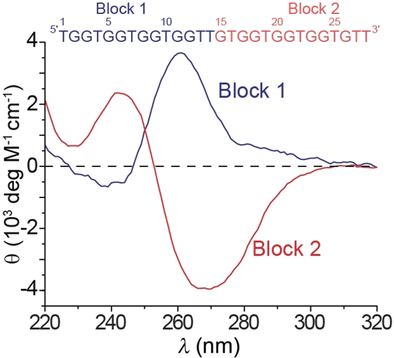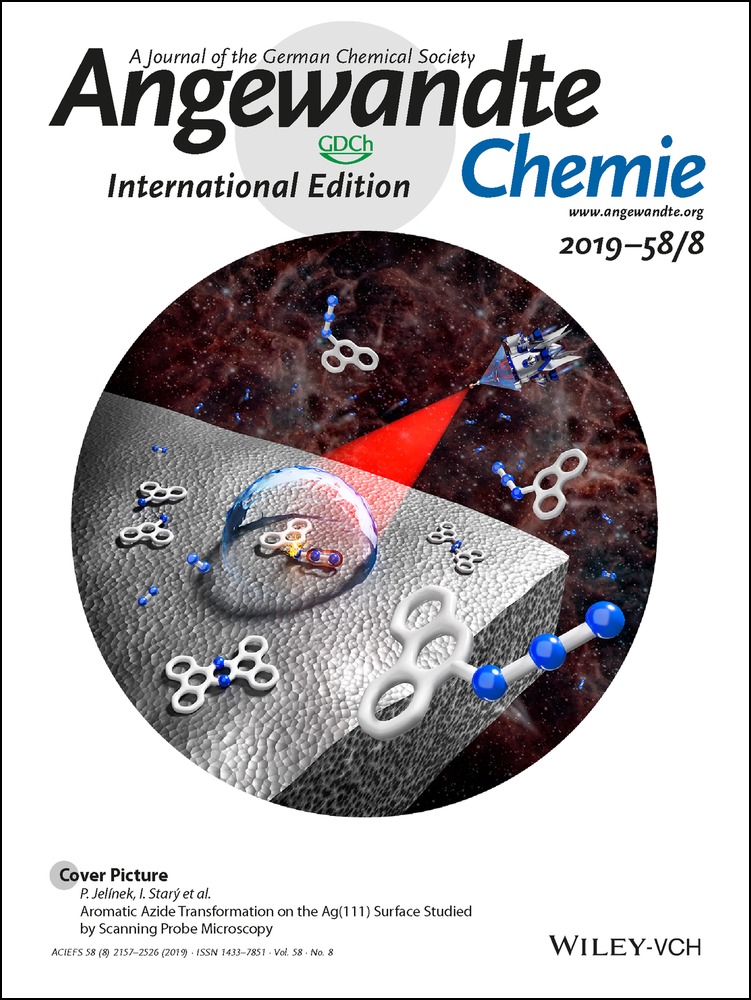A Minimal Sequence for Left-Handed G-Quadruplex Formation
Blaž Bakalar
School of Physical and Mathematical Sciences, Nanyang Technological University, Singapore, 637371 Singapore
School of Biological Sciences, Nanyang Technological University, Singapore, 637551 Singapore
Search for more papers by this authorDr. Brahim Heddi
School of Physical and Mathematical Sciences, Nanyang Technological University, Singapore, 637371 Singapore
Laboratoire de Biologie et Pharmacologie Appliquée, CNRS, Ecole Normale Supérieure Paris-Saclay, 94235 Cachan, France
Search for more papers by this authorDr. Emmanuelle Schmitt
Laboratoire de Biochimie, UMR 7654, CNRS, Ecole Polytechnique, 91128 Palaiseau, France
Search for more papers by this authorDr. Yves Mechulam
Laboratoire de Biochimie, UMR 7654, CNRS, Ecole Polytechnique, 91128 Palaiseau, France
Search for more papers by this authorCorresponding Author
Prof. Dr. Anh Tuân Phan
School of Physical and Mathematical Sciences, Nanyang Technological University, Singapore, 637371 Singapore
Search for more papers by this authorBlaž Bakalar
School of Physical and Mathematical Sciences, Nanyang Technological University, Singapore, 637371 Singapore
School of Biological Sciences, Nanyang Technological University, Singapore, 637551 Singapore
Search for more papers by this authorDr. Brahim Heddi
School of Physical and Mathematical Sciences, Nanyang Technological University, Singapore, 637371 Singapore
Laboratoire de Biologie et Pharmacologie Appliquée, CNRS, Ecole Normale Supérieure Paris-Saclay, 94235 Cachan, France
Search for more papers by this authorDr. Emmanuelle Schmitt
Laboratoire de Biochimie, UMR 7654, CNRS, Ecole Polytechnique, 91128 Palaiseau, France
Search for more papers by this authorDr. Yves Mechulam
Laboratoire de Biochimie, UMR 7654, CNRS, Ecole Polytechnique, 91128 Palaiseau, France
Search for more papers by this authorCorresponding Author
Prof. Dr. Anh Tuân Phan
School of Physical and Mathematical Sciences, Nanyang Technological University, Singapore, 637371 Singapore
Search for more papers by this authorGraphical Abstract
It's just a jump to the left: Based on analysis and modification of the two sequence blocks of the natural left-handed DNA G-quadruplex Z-G4, the 12-nt sequence GTGGTGGTGGTG was identified as a minimal sequence motif for left-handed G-quadruplex formation. This motif is abundant in the human genome.
Abstract
Recently, we observed the first example of a left-handed G-quadruplex structure formed by natural DNA, named Z-G4. We analysed the Z-G4 structure and inspected its primary 28-nt sequence in order to identify motifs that convey the unique left-handed twist. Using circular dichroism spectroscopy, NMR spectroscopy, and X-ray crystallography, we revealed a minimal sequence motif of 12 nt (GTGGTGGTGGTG) for formation of the left-handed DNA G-quadruplex, which is found to be highly abundant in the human genome. A systematic analysis of thymine loop mutations revealed a moderate sequence tolerance, which would further broaden the space of sequences prone to left-handed G-quadruplex formation.
Supporting Information
As a service to our authors and readers, this journal provides supporting information supplied by the authors. Such materials are peer reviewed and may be re-organized for online delivery, but are not copy-edited or typeset. Technical support issues arising from supporting information (other than missing files) should be addressed to the authors.
| Filename | Description |
|---|---|
| anie201812628-sup-0001-misc_information.pdf2.3 MB | Supplementary |
Please note: The publisher is not responsible for the content or functionality of any supporting information supplied by the authors. Any queries (other than missing content) should be directed to the corresponding author for the article.
References
- 1
- 1aM. Gellert, M. N. Lipsett, D. R. Davies, Proc. Natl. Acad. Sci. USA 1962, 48, 2013–2018;
- 1bD. Sen, W. Gilbert, Nature 1988, 334, 364–366.
- 2D. Rhodes, H. J. Lipps, Nucleic Acids Res. 2015, 43, 8627–8637.
- 3
- 3aP. J. Bates, J. B. Kahlon, S. D. Thomas, J. O. Trent, D. M. Miller, J. Biol. Chem. 1999, 274, 26369–26377;
- 3bT. Simonsson, M. Henriksson, Biochem. Biophys. Res. Commun. 2002, 290, 11–15;
- 3cH. Qi, C. P. Lin, X. Fu, L. M. Wood, A. A. Liu, Y. C. Tsai, Y. Chen, C. M. Barbieri, D. S. Pilch, L. F. Liu, Cancer Res. 2006, 66, 11808–11816;
- 3dN. Q. Do, W. J. Chung, T. H. A. Truong, B. Heddi, A. T. Phan, Nucleic Acids Res. 2017, 45, 7487–7493.
- 4
- 4aA. T. Phan, V. Kuryavyi, J. B. Ma, A. Faure, M. L. Andreola, D. J. Patel, Proc. Natl. Acad. Sci. USA 2005, 102, 634–639;
- 4bN. Q. Do, K. W. Lim, M. H. Teo, B. Heddi, A. T. Phan, Nucleic Acids Res. 2011, 39, 9448–9457;
- 4cD. Musumeci, C. Riccardi, D. Montesarchio, Molecules 2015, 20, 17511–17532;
- 4dM. Métifiot, S. Amrane, J. L. Mergny, M. L. Andreola, Biochimie 2015, 118, 173–175;
- 4eR. Perrone, E. Butovskaya, S. Lago, A. Garzino-Demo, C. Pannecouque, G. Palu, S. N. Richter, Int. J. Antimicrob. Agents 2016, 47, 311–316.
- 5
- 5aD. Miyoshi, H. Karimata, Z. M. Wang, K. Koumoto, N. Sugimoto, J. Am. Chem. Soc. 2007, 129, 5919–5925;
- 5bY. C. Huang, D. Sen, J. Am. Chem. Soc. 2010, 132, 2663–2671;
- 5cS. P. Liu, S. H. Weisbrod, Z. Tang, A. Marx, E. Scheer, A. Erbe, Angew. Chem. Int. Ed. 2010, 49, 3313–3316; Angew. Chem. 2010, 122, 3385–3388;
- 5dG. I. Livshits, A. Stern, D. Rotem, N. Borovok, G. Eidelshtein, A. Migliore, E. Penzo, S. J. Wind, R. Di Felice, S. S. Skourtis, J. C. Cuevas, L. Gurevich, A. B. Kotlyar, D. Porath, Nat. Nanotechnol. 2014, 9, 1040–1046;
- 5eJ. Thevarpadam, I. Bessi, O. Binas, D. P. Goncalves, C. Slavov, H. R. Jonker, C. Richter, J. Wachtveitl, H. Schwalbe, A. Heckel, Angew. Chem. Int. Ed. 2016, 55, 2738–2742; Angew. Chem. 2016, 128, 2788–2792.
- 6
- 6aJ. T. Davis, Angew. Chem. Int. Ed. 2004, 43, 668–698; Angew. Chem. 2004, 116, 684–716;
- 6bS. Burge, G. N. Parkinson, P. Hazel, A. K. Todd, S. Neidle, Nucleic Acids Res. 2006, 34, 5402–5415;
- 6cD. J. Patel, A. T. Phan, V. Kuryavyi, Nucleic Acids Res. 2007, 35, 7429–7455.
- 7
- 7aM. Webba da Silva, M. Trajkovski, Y. Sannohe, N. Ma′ani Hessari, H. Sugiyama, J. Plavec, Angew. Chem. Int. Ed. 2009, 48, 9167–9170; Angew. Chem. 2009, 121, 9331–9334;
- 7bL. Hu, K. W. Lim, S. Bouaziz, A. T. Phan, J. Am. Chem. Soc. 2009, 131, 16824–16831;
- 7cP. Agrawal, C. Lin, R. I. Mathad, M. Carver, D. Yang, J. Am. Chem. Soc. 2014, 136, 1750–1753;
- 7dM. Marušič, J. Plavec, Angew. Chem. Int. Ed. 2015, 54, 11716–11719; Angew. Chem. 2015, 127, 11882–11885.
- 8
- 8aN. Q. Do, A. T. Phan, Chem. Eur. J. 2012, 18, 14752–14759;
- 8bM. Trajkovski, M. W. da Silva, J. Plavec, J. Am. Chem. Soc. 2012, 134, 4132–4141.
- 9
- 9aD. Miyoshi, H. Karimata, N. Sugimoto, J. Am. Chem. Soc. 2006, 128, 7957–7963;
- 9bM. C. Miller, R. Buscaglia, J. B. Chaires, A. N. Lane, J. O. Trent, J. Am. Chem. Soc. 2010, 132, 17105–17107;
- 9cB. Heddi, A. T. Phan, J. Am. Chem. Soc. 2011, 133, 9824–9833.
- 10
- 10aV. T. Mukundan, A. T. Phan, J. Am. Chem. Soc. 2013, 135, 5017–5028;
- 10bB. De Nicola, C. J. Lech, B. Heddi, S. Regmi, I. Frasson, R. Perrone, S. N. Richter, A. T. Phan, Nucleic Acids Res. 2016, 44, 6442–6451.
- 11
- 11aZ. Yu, V. Gaerig, Y. Cui, H. Kang, V. Gokhale, Y. Zhao, L. H. Hurley, H. Mao, J. Am. Chem. Soc. 2012, 134, 5157–5164;
- 11bK. W. Lim, A. T. Phan, Angew. Chem. Int. Ed. 2013, 52, 8566–8569; Angew. Chem. 2013, 125, 8728–8731.
- 12M. Gajarský, M. L. Živković, P. Stadlbauer, B. Pagano, R. Fiala, J. Amato, L. Tomáška, J. Šponer, J. Plavec, L. Trantírek, J. Am. Chem. Soc. 2017, 139, 3591–3594.
- 13V. Limongelli, S. De Tito, L. Cerofolini, M. Fragai, B. Pagano, R. Trotta, S. Cosconati, L. Marinelli, E. Novellino, I. Bertini, A. Randazzo, C. Luchinat, M. Parrinello, Angew. Chem. Int. Ed. 2013, 52, 2269–2273; Angew. Chem. 2013, 125, 2325–2329.
- 14V. Kocman, J. Plavec, Nat. Commun. 2017, 8, 15355.
- 15
- 15aN. Maizels, L. T. Gray, PLoS Genet. 2013, 9, e 1003468;
- 15bA. Bedrat, L. Lacroix, J. L. Mergny, Nucleic Acids Res. 2016, 44, 1746–1759;
- 15cV. S. Chambers, G. Marsico, J. M. Boutell, M. Di Antonio, G. P. Smith, S. Balasubramanian, Nat. Biotechnol. 2015, 33, 877–881.
- 16W. J. Chung, B. Heddi, E. Schmitt, K. W. Lim, Y. Mechulam, A. T. Phan, Proc. Natl. Acad. Sci. USA 2015, 112, 2729–2733.
- 17M. Adrian, F. R. Winnerdy, B. Heddi, A. T. Phan, Biophys. J. 2017, 113, 775–784.
- 18J. Kypr, I. Kejnovska, D. Renciuk, M. Vorlickova, Nucleic Acids Res. 2009, 37, 1713–1725.
- 19C. J. Lech, B. Heddi, A. T. Phan, Nucleic Acids Res. 2013, 41, 2034–2046.
- 20
- 20aJ. L. Huppert, S. Balasubramanian, Nucleic Acids Res. 2005, 33, 2908–2916;
- 20bA. K. Todd, M. Johnston, S. Neidle, Nucleic Acids Res. 2005, 33, 2901–2907.





